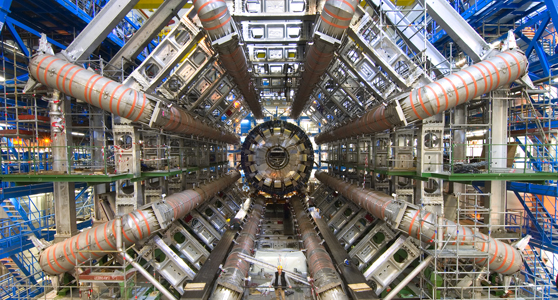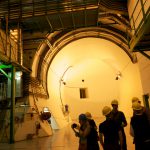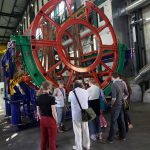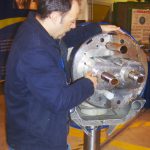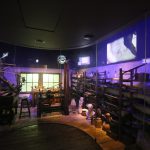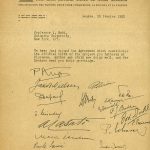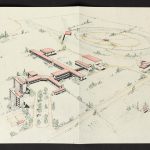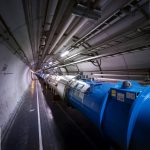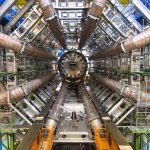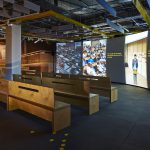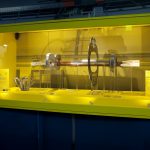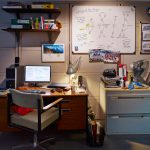Curating the collider: using place to engage museum visitors with particle physics
Abstract
https://dx.doi.org/10.15180/140207/001CERN’s Large Hadron Collider, the world’s largest particle physics facility, provides museological opportunities and challenges. Visitor interest in cutting-edge physics, with its high media profile, is tempered by anxiety about understanding complex content. The topic does not readily lend itself to traditional museum showcase-dominated displays: the technology of modern particle physics is overwhelmingly large, while the phenomena under investigation are invisible. For Collider, a major temporary exhibition, the Science Museum adopted a ‘visit to CERN’ approach, recreating several of the laboratory’s spaces. We explore the effectiveness of this approach, at a time when historical studies of scientific laboratories and museum reconstructions of spaces are subject to renewed interest.
Keywords
CERN, Collider, Large Hadron Collider, Museum, particle physics, place, re-creation, room set, Science Museum, space
Introduction
https://dx.doi.org/10.15180/140207/002Collider: step inside the world’s greatest experiment ran at the Science Museum from November 2013–May 2014 and is touring internationally until 2017. The exhibition covers the work of the Large Hadron Collider (LHC) at CERN, the world’s largest particle physics facility. Strategically, the subject matter had obvious appeal for the Science Museum, with its long term ambitions to tackle complex scientific topics, attract more adult visitors, and raise its international profile (Science Museum, 2012). Practically, creating an appealing exhibition around often abstract subject matter and unfamiliar objects was a curatorial challenge, and required an unusual approach.
Audience research on previous LHC-themed exhibitions at the Science Museum and CERN’s visitor centre gave some pointers (Hobson, 2012). To attract visitors in the first place, the Museum had to overcome intimidation around the subject matter: most visitors had heard of the LHC via media coverage, and were interested in finding out more about it, but many feared they would not be able to understand an exhibition.[1] Alongside the non-specialists who make up the majority of Science Museum visitors, the exhibition was likely to attract people with a deeper interest in particle physics, so the Museum needed to create something novel for them. Visitors were interested in real objects from CERN, but these were unfamiliar and needed to be set in context; also, for obvious reasons, it was impossible to display the LHC’s operational technology so the exhibition would have to rely on a relatively small number of prototype or spare components which could fit into a museum gallery. The main challenges were somehow to convey the extremes of the LHC’s scale – large-scale engineering and the invisible microworld – and to answer a key visitor question: ‘What’s the point of doing all this?’
From an early stage in the development process, we decided that the exhibition would take the form of a ‘visit to CERN’. This was motivated by a number of research trips to the laboratory, and the experience of having the workings of the LHC explained repeatedly by a variety of physicists and engineers. It became clear that the combination of on-site visits and personal storytelling was an effective way of communicating complex material. In particular, the specialised objects around which the exhibition is built acquired new meaning and significance when set in their working environments and explained by the individuals who designed, built and operate them.
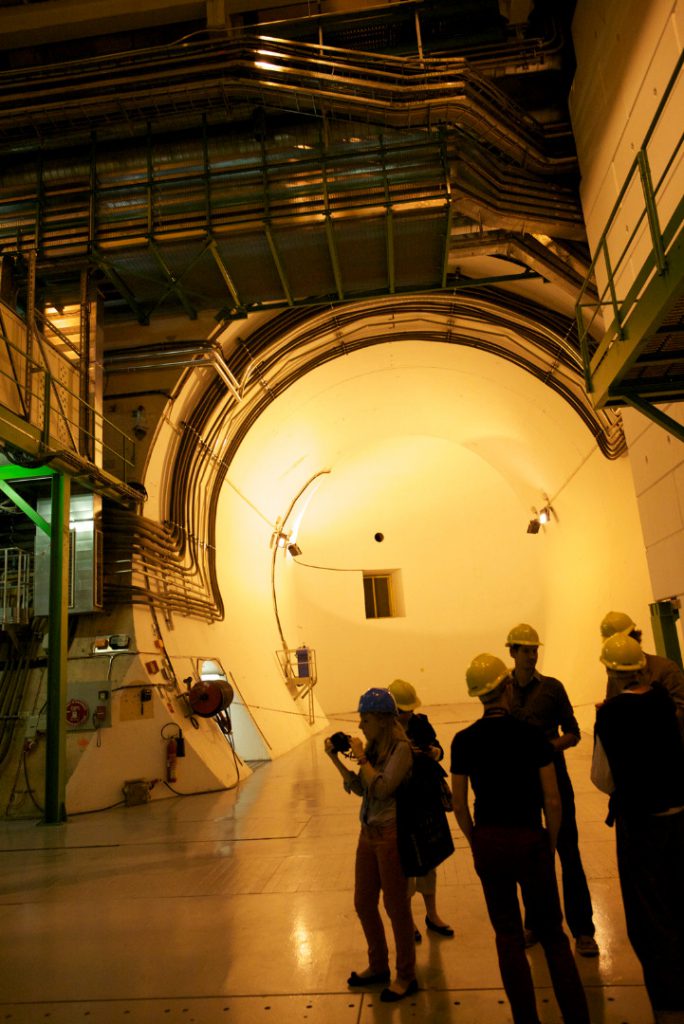
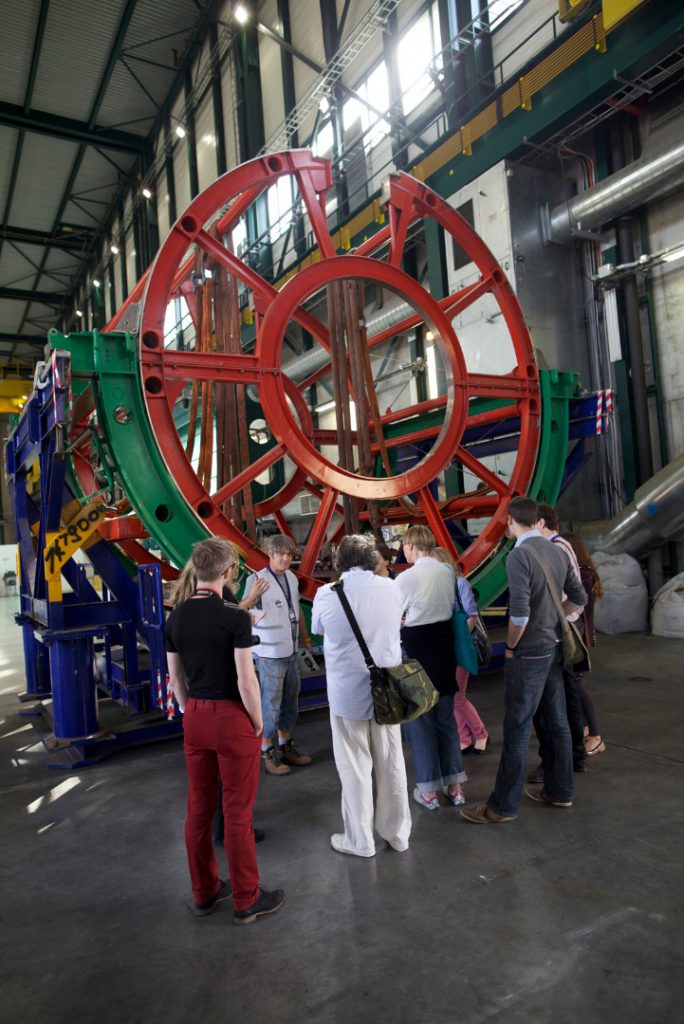
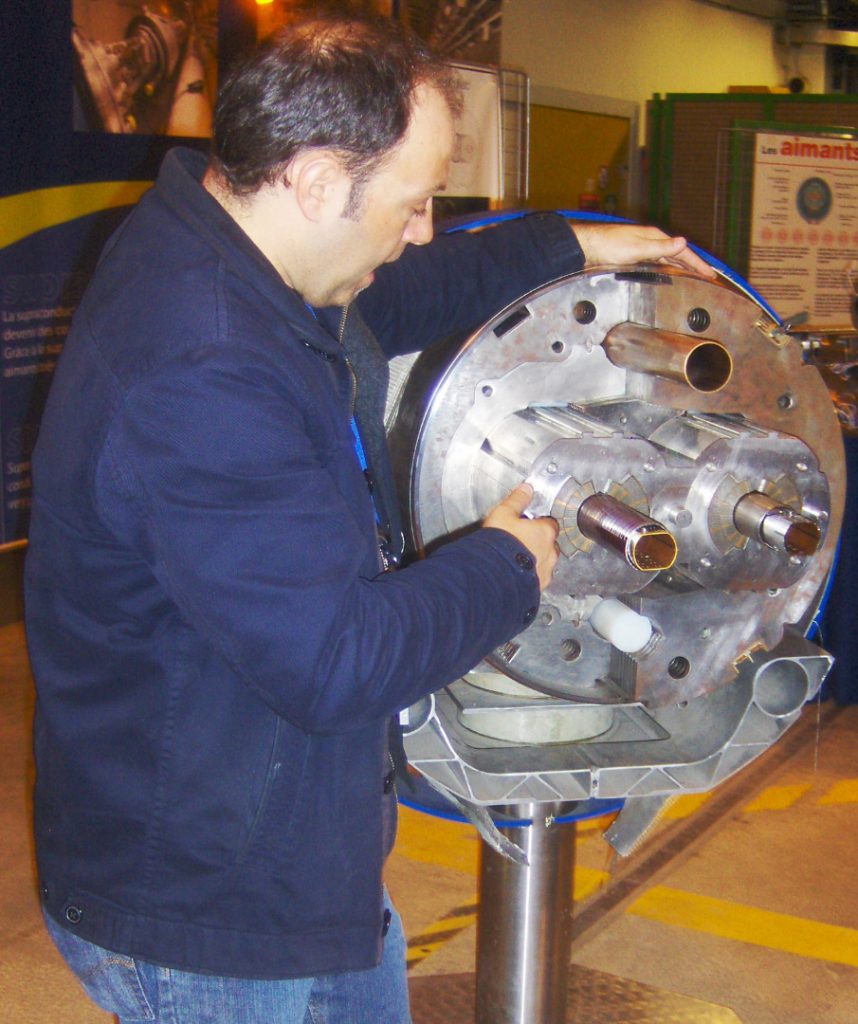
In creating our ‘visit to CERN’ we drew on insights from the three disciplines core to the Science Museum: historians’ insights into the spaces of science; the first-hand experience of scientists; and museological techniques in recreating spaces to provide a three-dimensional visitor experience.
Place in museums
https://dx.doi.org/10.15180/140207/003Museums attach huge weight to offering the ‘real thing’ via the original objects on display. However, as Kevin Moore (1997) has argued, the ‘real thing’ loses part of its power when decontextualized from its ‘real place’. While historic houses and on-site museums are able to show material culture in something close to its original setting, many museums operate at a far remove from an object’s original context of use. This is particularly the case for large museums where objects are frequently of national and international, rather than local, significance. While it would be desirable to preserve and interpret artefacts in situ, this is not always feasible; even so, it is possible for museums and heritage attractions to recreate ‘a sense of real things in a real place’ by creating room sets or buildings (Moore, 1997, p 140). Museum professionals are often bemused by the popularity among visitors of inauthentic or even tacky reconstructions; yet Moore argues that high-quality versions – especially when combined with the testimony of ‘real’ people (as opposed to museum staff) – can provide genuinely powerful experiences.
Museum reconstructions tended to fall out of favour in the late twentieth century, in large part due to concerns over lack of historical accuracy. But in recent years they have undergone something of a resurgence. One justification has been that visitors are perfectly capable of identifying them as spectacle rather than reality, and enjoying them as such. However, curators must be careful to ensure that the information they are seeking to convey is not swamped by visitors’ affective responses to the setting (Bryant, 2009).
Julius Bryant identifies a range of approaches. Painstaking reconstructions of spaces with their original artefacts, fully provenanced – for example Francis Bacon’s studio at the Hugh Lane Gallery in Dublin or Jeanne Lanvin’s apartment at the Musée des Arts Décoratifs in Paris – are often presented as an ‘objective period room…caged in a box’ with the visitor as voyeur (Bryant, 2009, p 80). At the other extreme, the Deutsches Auswandererhaus in Bremerhaven, with its theatrical recreations of various spaces encountered by German emigrants to America in the nineteenth and early twentieth centuries, might be termed a ‘museological melange’, a hybrid that is more a reflection of the curator’s creativity rather than a very authentic reconstruction of a time or setting (Bryant, 2009, p 80).
This range of approaches can also be seen in reconstructed scientific laboratories and technology workshops, though these perhaps present a more challenging prospect for the visitor than the more familiar domestic settings encountered in many heritage sites or art and design museums.
As Ken Arnold notes, the main appeal of visiting the Alexander Fleming Laboratory Museum at St Mary’s Hospital in London is the feeling of ‘palpable magic’ at being in the very place of Fleming’s famous 1928 discovery of penicillin (Arnold, 1996, p 70). The laboratory itself, restored to resemble its original furnishings and displaying some objects owned by Fleming alongside typical equipment of the period, is somewhat opaque to visitors, but brought to life by the Museum’s volunteer guides.
The magic of the real is also exploited by the Science Museum’s display of James Watt’s workshop. Acquired as something of a shrine in 1924, for most of its museum life it was displayed as an objective room in a box with visitors peering through a window. For its redisplay in 2012, the exhibition team attempted to give visitors more of a sense of being inside the workshop by creating a curved glass case so that visitors could stand surrounded by the workshop contents. Surrounding exhibits explored Watt’s work within the broader context of manufacture in the late eighteenth century (Russell, 2014). The display succeeded in giving visitors a sense of atmosphere and intrigue, and a contextual background to Watt’s working methods, although in audience evaluation visitors indicated that they wanted more in-depth explanations of what all the objects in the workshop were (McSweeney, 2012).
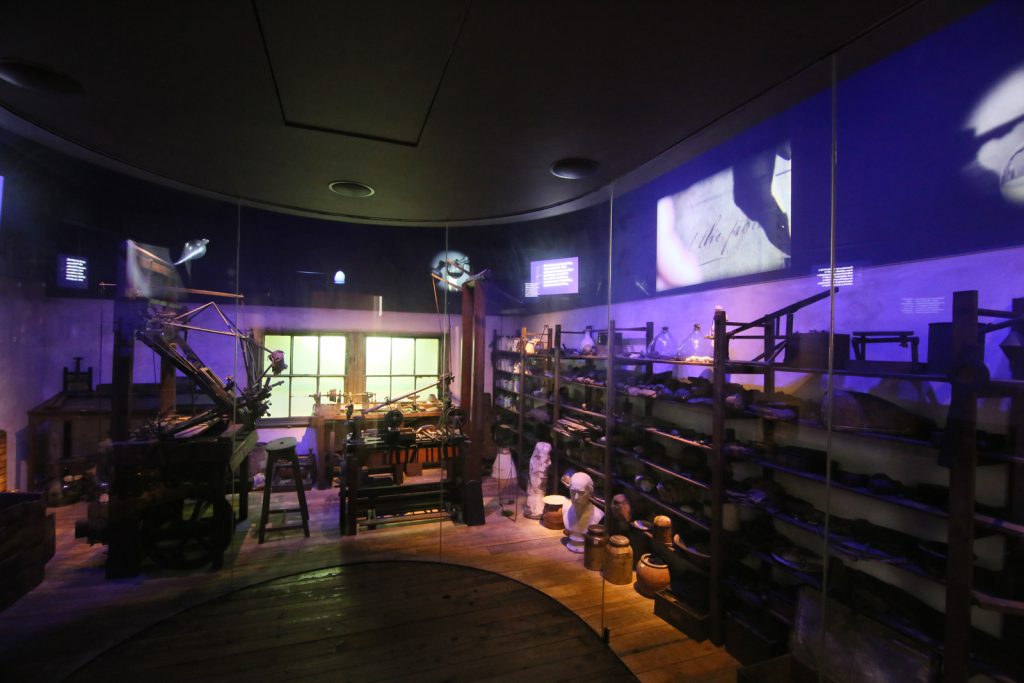
The contrasting approach, of displaying real scientific objects within simulated spaces, has also met with mixed success. Empires of Physics, a 1993 exhibition at the Whipple Museum of the History of Science in Cambridge, explored the production and dissemination of physics in the late nineteenth century. The exhibition’s two spaces, on different floors, contrasted laboratory settings – teaching and research in the Cavendish Laboratory and manufacture in the Cambridge Scientific Instrument Company – with the types of displays typically seen at international exhibitions (Bennett, 1995).
Entering the first gallery, The Laboratory, visitors encountered a private world, with equipment set up ready for experiments, and crowded shelves of objects. Museum-style labels were absent: the curious visitor was instead invited to browse items true to the setting, such as instrument catalogues, or laboratory manuals. In the second gallery, The Exhibition, objects were displayed in a more orderly fashion, with labels and working exhibits; the work-in-process seen in The Laboratory now displayed as the products of science.
Arnold described Empires of Physics as ‘a brave attempt to experiment with using the real space of an exhibition to suggest that science does not come ready made, but has to be both created and presented’, but cautioned that visitors who didn’t read the guidebook or speak with the Museum’s demonstrators were at a loss to understand the premise, particularly struggling with the lack of explicit interpretation in The Laboratory (Arnold, 1996, p 69).
We were conscious that telling the story of the Large Hadron Collider through recreated spaces would be difficult, but had the potential to work well if these issues were thoughtfully considered. While it could be argued that current particle physics, with its high media profile, is actually an easier prospect for visitors than eighteenth century engineering or nineteenth century physics, the spaces of CERN would be highly unfamiliar. Due to their size, the LHC spaces could not be recreated entirely faithfully within a museum gallery, so a ‘museological melange’ drawing on the creativity of the curatorial and design teams would be required.
Place and particle physics
https://dx.doi.org/10.15180/140207/004The study of space is a well-established tool in history of science. David Finnegan (2008) identifies broad categories of study over the past few decades: detailed histories of specific sites; exploration of how science is bound up in regional and national identities; territorial claims, whether intellectual, material, or political; and the changing boundaries across which scientific expertise moves.[2]
Scientific laboratories, as privileged places of scientific activity, enjoyed considerable attention in the 1980s and 1990s. However, in recent years many historians have moved away from microstudies of mainstream laboratories and instead turned their attention to wider sites of scientific activity (such as the home, or the pub), or to the relationship between science and various publics. In a 2008 issue of Isis on the subject of bringing laboratory history back into focus, Robert E Kohler argued that it was time for a revival of studying the lab as a social institution, building on studies of individual places to create more systematic macrosocial histories of the laboratory in different eras (Kohler, 2008).
During the boom in laboratory studies, large particle physics facilities attracted particular attention, and historians overlapped with sociologists and anthropologists of science. Notable studies in the field include Sharon Traweek’s Beamtimes and Lifetimes, exploring the different manifestations of power and gender relations in laboratories in America and Japan, and Peter Galison’s Image and logic, which explored how the ever-larger and more specialised technologies of particle physics were developed and managed by different subcultures within engineering and physics disciplines (Traweek, 1992; Galison, 1997). Although each laboratory is unique, broad common characteristics of spaces can be identified.
From the Second World War until the mid-1960s, a factory model dominated the architecture of large-scale physics facilities. Hundreds of workers were based at centralised facilities, often sharing common layouts: at a 1947 London meeting ‘Discussion on the Design of Physics Laboratories’, several participants advocated basing the site around a hub, with scientific staff at the centre while services and other activities were relegated to the periphery. However, as Galison and Jones note, the growth in electronic infrastructure and data sharing from the 1970s onwards meant that experiments could not be considered as taking place solely at a single facility (Galison and Jones, 1999). Famously, the distributed communications and work practices of particle physicists foreshadowed a transformation far beyond their discipline: Tim Berners-Lee’s 1989 proposal for managing the large amounts of information generated by CERN’s experiments became the model for the World Wide Web (Berners-Lee, 1989). In this connected world, it is useful to consider the international physics community in light of Karin Knorr-Cetina’s description of ‘a sort of collaborating organism’ in which large experimental consortia can draw in virtually all scientists working in the field (Knorr-Cetina, 1992, p 133).
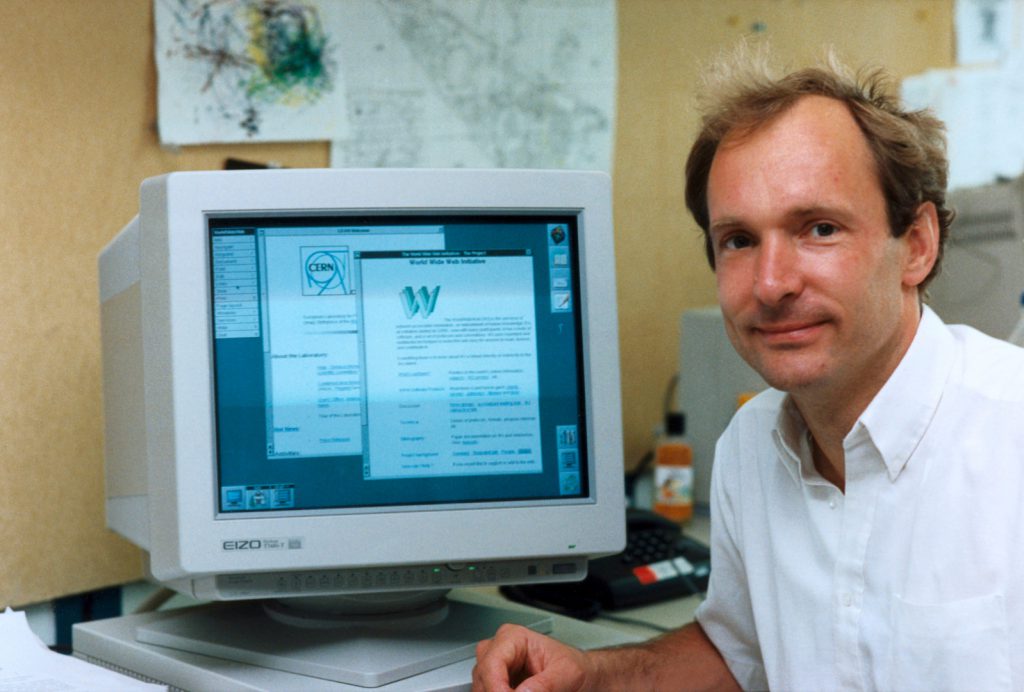
CERN: a place to bring people together
https://dx.doi.org/10.15180/140207/005But what kind of combination of created space and original objects would convey the essence of CERN in an engaging way to visitors? The following section explores the history, construction and daily working conditions of CERN that informed the creation of Collider.
This year, CERN celebrates its 60th anniversary, marking the ratification of its convention on 29 September 1954. It was a slow and sometimes painful birth. In the shadow of the Second World War and the atomic bomb, the widespread wish to concentrate on peaceful scientific research while re-building international relations (and, in Europe, stem further ‘brain drain’ to the US) provided the context for scientists’ and politicians’ many and varied discussions about possible collaborations and international facilities.[3]
Plans for a pan-European laboratory for nuclear research gained traction in the 1950s. They were supported by interested parties from the US, led by Isidor Rabi, who considered that such a scheme could act as a Marshall Plan for science, uniting and strengthening the European research base and isolating the Soviet Union (Krige, 2005). In particular, the United States hoped to benefit economically and militarily by applying fundamental scientific discoveries made in Europe, as it had done with great success before the war.
In February 1952, the Conseil Européen pour la Recherche Nucléaire was provisionally founded. Geneva, Paris, Copenhagen and Arnhem were all proposed as sites for the new lab, with Geneva emerging as the chosen host – Switzerland’s neutrality was an important selling point, confirming that the new laboratory would eschew military research. Construction work began in May 1954, and in September the convention of the European Organisation for Nuclear Research was signed by 12 member states. The Council was dissolved, but the acronym CERN stuck.

Throughout its history, CERN has extended its reach beyond Europe, with scientists from more far-flung institutions collaborating on experiments. Today, it is in the privileged position of hosting the world’s only facility for multi-purpose physics experiments at very high energies. The Large Hadron Collider (LHC) was originally designed as Europe’s competitor to the American Superconducting Super Collider (SSC) and Russian UNK. With the cancellation of the SSC in 1993 and suspension of work on UNK in 1998, CERN was left with a monopoly on the next generation of large accelerator technology (Nekhai, 2011; Riordan, 2000). The LHC’s only competitor, Fermilab’s Tevatron, ceased operations in 2011 as it could not reach the higher energies of its newer rival. The US and Russia are observer states of CERN, and the organisation continues to expand its international affiliations.[4] These days, CERN’s Director-General Rolf Heuer likes to say that the E in CERN now stands for ‘everyone’.[5] Conveying the international and collaborative nature of work at CERN would be a key element of the exhibition.
Everyone who goes to CERN needs to interact in a physical space. In developing campus plans for the ill-fated Superconducting Super Collider, architect Moshe Safdie reviewed how scientists interacted in large-scale facilities. Consideration of interpersonal relations had been factored in to the planning of major campuses in the past: Chicago’s Fermilab physics laboratory (where construction began in 1967) was focused on a high-rise central building with offices and laboratories above the main parts of the accelerator ring, while at the Salk Institute of Biological Sciences in La Jolla, California (where construction began in 1962), a long courtyard connected a mix of spaces optimised for solitude or collaboration. CERN, by contrast, seemed to Safdie to have no such planning: although the first building works in the 1950s followed an architectural scheme, over the subsequent half century CERN has expanded ‘almost like a medieval town, having begun to grow outward from one end. In apparent disorder, its workshops, laboratories and central meeting spaces spread out over the landscape’ (Safdie, 1999, p 490). Disorganisation somehow worked: particle physicists told Safdie that when they travelled to collaborate on an experiment, the only place they casually met people was CERN. Safdie put this down to the network of horizontal passages and tunnels that connected buildings with different functions, and provided sheltered access to the central building with large group meeting places such as the main auditorium and café (he noted that the good coffee served there was also a contributing factor to CERN’s congenial environment).
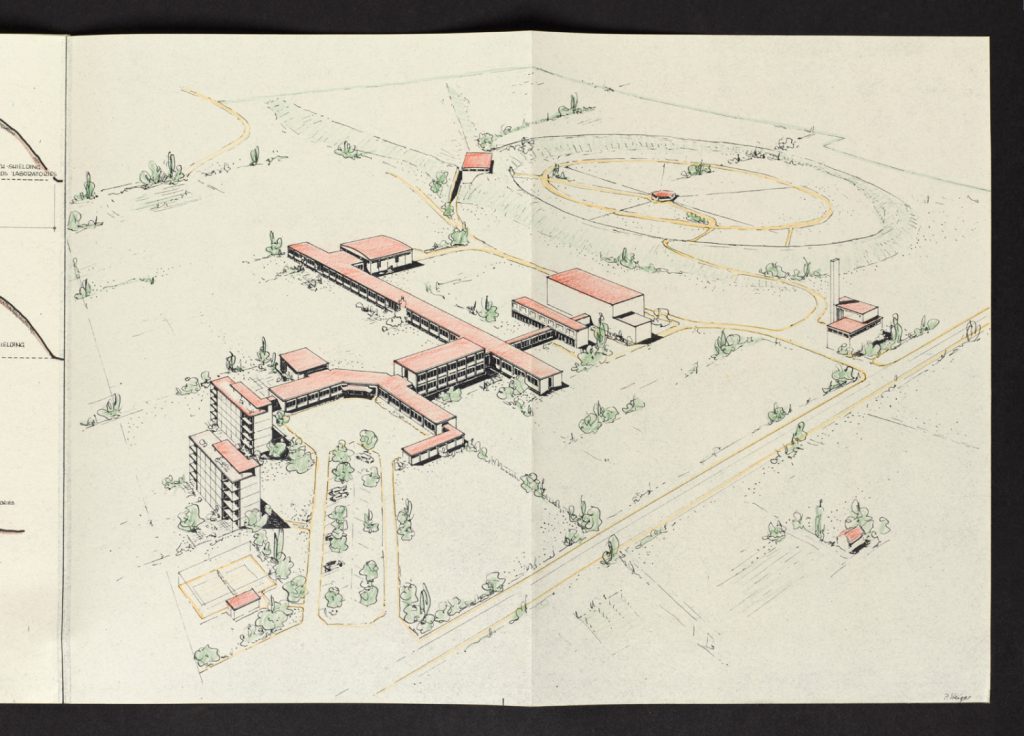
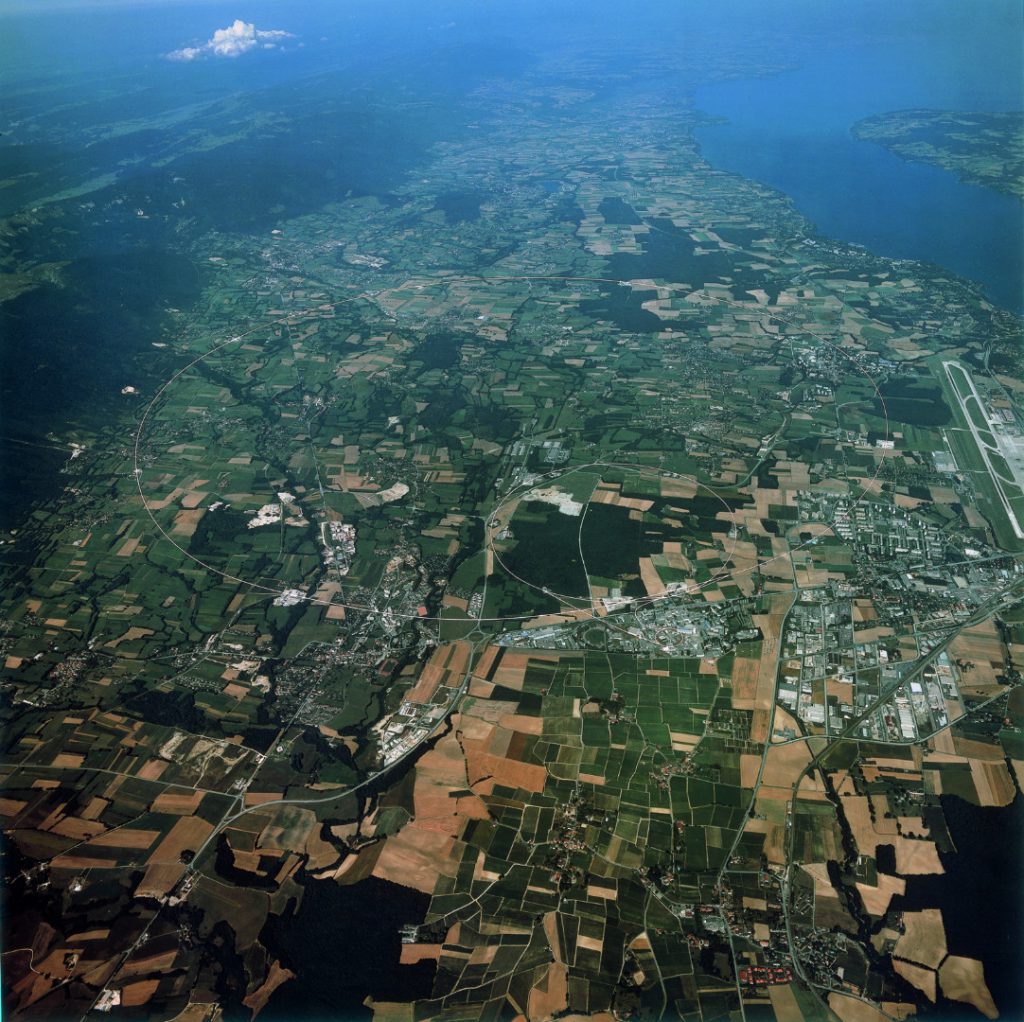
CERN’s sociability is noticeable at a very personal level – during a study of its Theory Division in the 1990s, Martina Merz noted that along the theorists’ long office corridors the doors were usually left open (Merz, 1998). They were frequently adorned with posters for conferences, often long expired, a strong reminder of the travel culture of the professional physicist.
Today, many experimental physicists are based at distant universities or research institutes, but stay connected to the centre of activity via email and weekly online meetings. (For a discussion of CERN’s many different categories of ‘physicist’, concerned with theory, data analysis and detector construction, see Roy, 2012.) They are able to access the data and tools required for their work from any location with an internet connection thanks to the Worldwide LHC Computing Grid, a globally distributed cloud computing system developed specifically to process, analyse and store the LHC data (Bird, 2011).
Nevertheless, physical meetings in actual spaces seem to remain important. Members of CERN’s global ‘collaborating organism’ make regular visits to the campus, in particular during ‘collaboration weeks’ when members of an experimental collaboration gather at CERN for intensive meetings and discussions. While there, physicists can make use of satellite offices maintained by their home institutions. These spaces reflect the personalities and interests of successive generations of employees, with posters, whiteboard sketches and personal possessions often remaining in place long after an individual has departed, or even left the field entirely. One of the authors (Harry Cliff) has found that it is not uncommon to enquire after the owner of, say, a bicycle part, only to be told by an old hand that it’s been there since at least 1997 and probably belonged to A N Other, now based in Chicago, but nobody is quite sure. The community atmosphere of CERN, its connected physical structures, the daily human interactions and experiences of the staff seemed crucial to convey to audiences.
Extreme places: the Large Hadron Collider
https://dx.doi.org/10.15180/140207/006The LHC (Evans and Bryant, 2008; Evans, 2009), referred to by CERN staff as ‘the machine’, was four decades in the making. Unprecedented in scale and technical sophistication, it would take a global consortium including CERN’s European members and the United States to meet the eye-watering costs of development and construction. After an embarrassing false-start in September 2008, the Collider began delivering data in late 2009, with the promise of answers to many of the great unsolved problems in fundamental physics.
The subterranean world of the LHC stands in stark contrast with the somewhat shabby surface campus, a contrast we were keen to see play out in the exhibition. Those who get a chance to go below ground must first don a safety helmet and radiation badge and pass through a series of airlock-like security doors, all of which serve to heighten the sense of passing into an unfamiliar and possibly dangerous domain. A lift then transports visitors a hundred metres below ground to the experimental areas.
The LHC is housed in a 27km concrete tunnel beneath the Franco-Swiss border. Running along the outside edge is the Collider itself, a steel tube in blue and white vanishing into the distance in each direction. Inside this blank shell are thousands of superconducting electromagnets, guiding beams of subatomic particles around the ring at 99.999997 per cent of the speed of light.
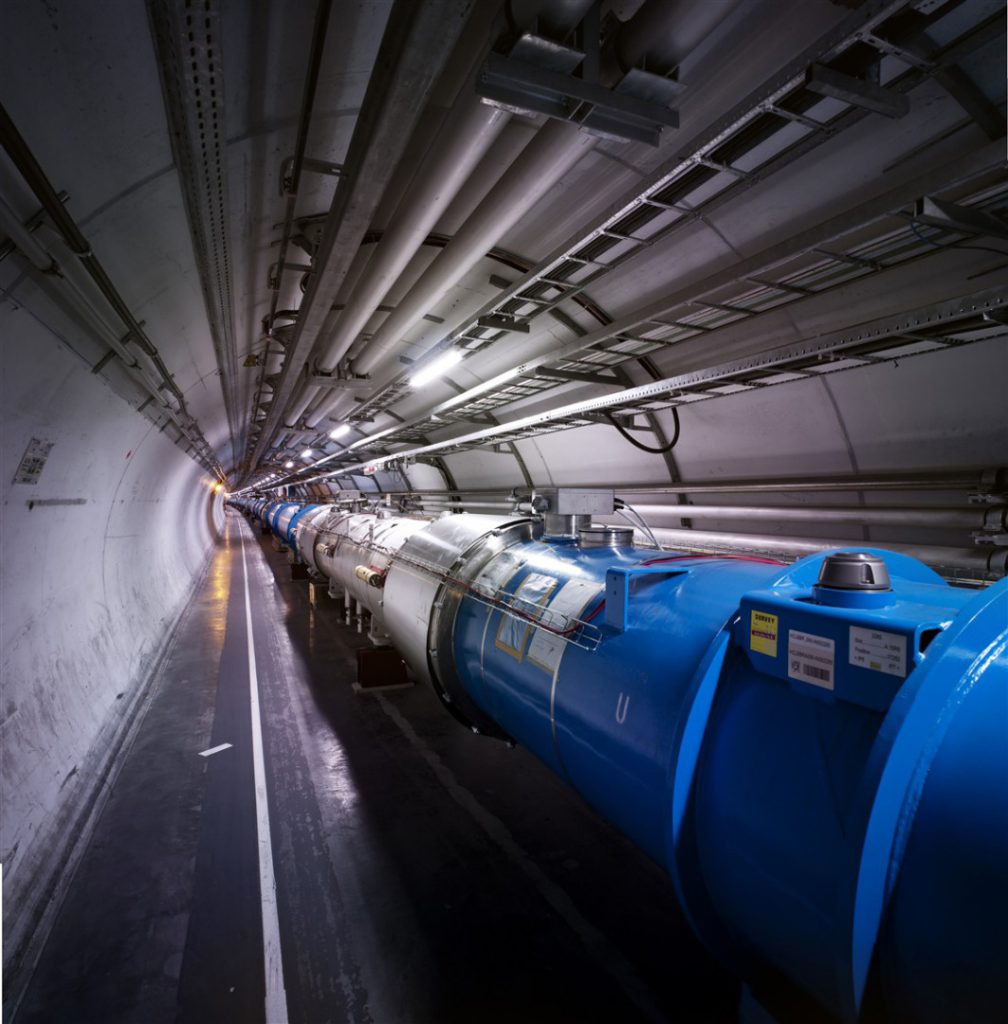
At four points on the ring the tunnel emerges into concrete caverns housing the four giant detectors – ATLAS, ALICE, CMS and LHCb. A visitor’s first reaction to encountering a detector is usually a mix of awe and disorientation as they crane their neck in an attempt to take in the full size of the machine. During operation, the particle beams are brought into collision inside these detectors, which produce 3D records of each collision up to 40 million times every second. Recreating the extraordinary experience of walking through the LHC tunnel and encountering a particle detector would be a key challenge for the exhibition team.
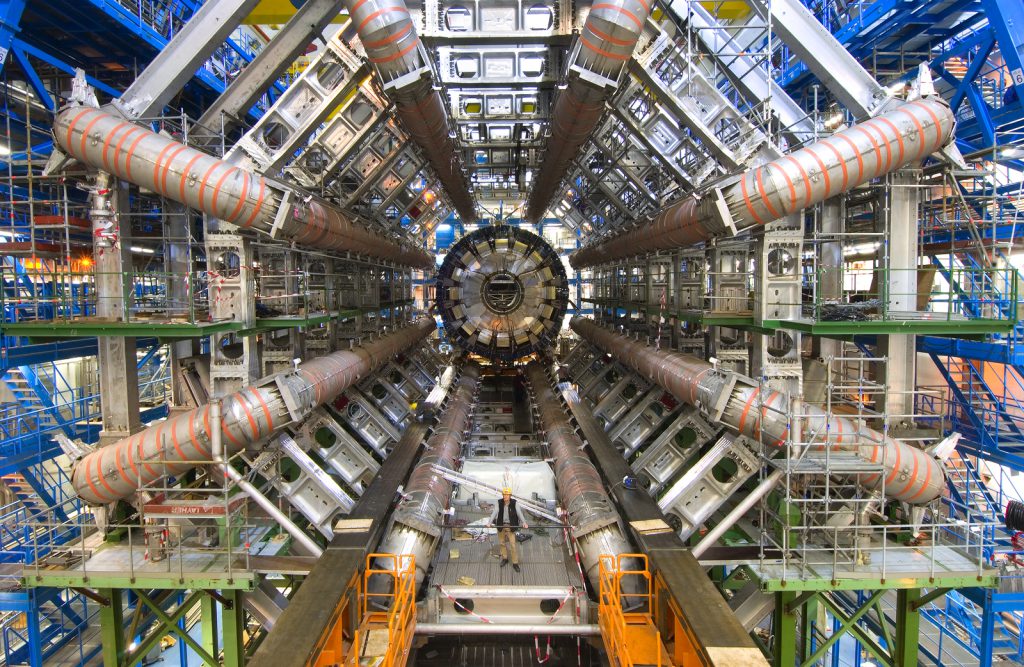
Back on the surface, the centre of activity is the CERN Control Centre (CCC). Here at the LHC’s ‘Mission Control’ a small team of engineers operate the Collider and its supporting infrastructure from an arc of computer monitors. For the most part the CCC is a tranquil place, occasionally interrupted by moments of activity, and even drama when problems arise. The engineers who work here refer to ‘the machine’ almost as if it were a living thing, many of them having spent long hours in the tunnel at work on the Collider itself. This link between man and machine made a strong impression on the exhibition team, and offered a potential way to engage visitors in what could otherwise seem an impersonal if impressive piece of scientific kit. One engineer in particular who spoke of his emotional bond with the Collider would provide inspiration for a main fictional character in the exhibition.
Recreating CERN’s spaces in an exhibition
https://dx.doi.org/10.15180/140207/007The bulk of the Collider exhibition is concerned with recent and current work being done at the LHC. This was a decision taken from the outset, despite CERN’s rich and interesting history, due to fairly limited space and the likely interests of international touring venues. There was also a concern that historic objects, many of which were never used at CERN, would be incongruous or confusing displayed in the context of a ‘visit to CERN’ (Boyle, 2014). The historical overview was therefore separated from the main part of the exhibition, and was presented as a fairly ‘classic’ museum display of objects from CERN, UK universities and the Science Museum’s own collection. This explored early atomic and nuclear physics, and the foundation of CERN and its links to Cold War geopolitics. Visitors then moved on to their ‘visit’ to present-day CERN and the Large Hadron Collider.
Ludmilla Jordanova has suggested in this journal that public interest in the LHC has been generated, at least in part, by its ‘heroisation, its monumentality, even its cost’ (Jordanova, 2014). As much as the exhibition team wished to avoid hagiographic accounts of high-profile individuals such as Peter Higgs and put the ordinary scientists and engineers centre-stage, it is undeniable that the LHC itself ends up the hero of the piece. As the largest, most complex and most expensive scientific device ever built, involving the greatest number of scientists ever to work on a peaceful project, operating at extremes of temperature and probing questions about the nature of the universe, it is a compelling hook to attract visitors to a ticketed temporary exhibition (see Hobson, 2012). The machine’s ‘wow facts’ featured heavily in the exhibition marketing campaign.
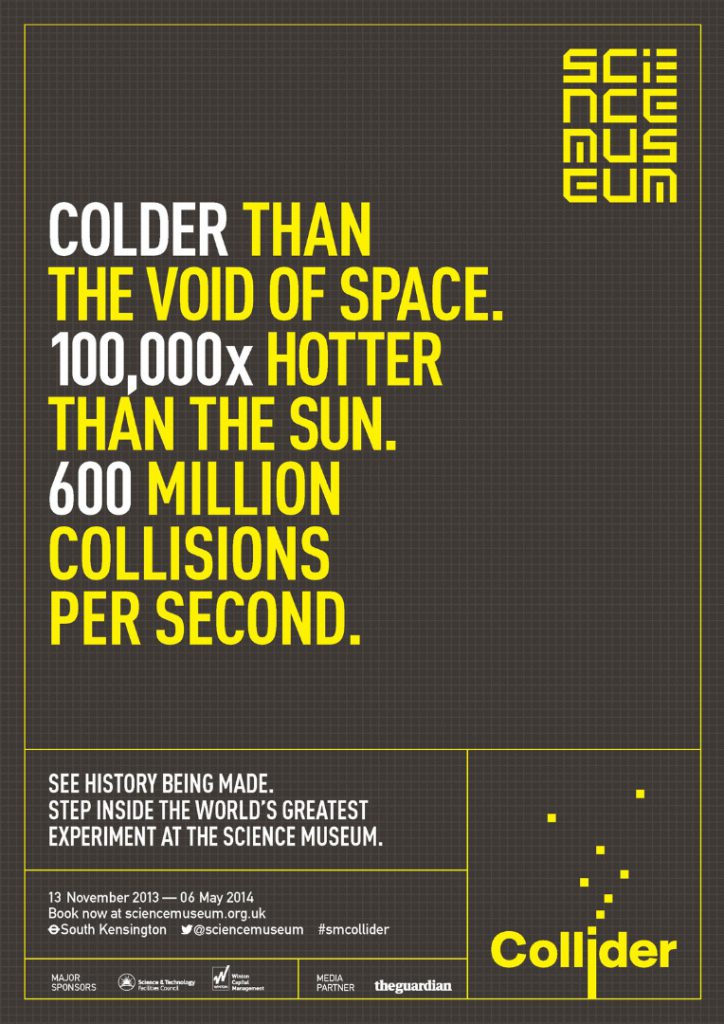
However, the ‘hero LHC’ was something of a double-edged sword for the exhibition team. We hoped that visitors’ curiosity about the machine might help overcome their fear of physics at least to the point of buying an exhibition ticket. On the other hand, the design would have to somehow get across to visitors the awe inspired by the real thing: it is an unforgettable experience when you first enter a CERN experimental cavern to find yourself faced with a five storey-high detector, bristling with micro-electronics and looking like something taken straight out of a science fiction blockbuster. The exhibition space would be a tiny fraction of this size.
Conscious of the need to create compelling reconstructions of CERN spaces while ensuring the safety of borrowed objects on display, the Museum appointed Nissen Richards Studio (NRS), a design firm with expertise both in museums and theatre, as creative lead for the project. NRS brought with them several theatre professionals including playwright Michael Wynne and video designer Finn Ross, both recipients of Olivier Awards. Through a series of intensive workshops the curatorial and design team mapped out various possible visitor journeys and narratives for the exhibition, as well as discussing the relative merits of a dramatic versus documentary style. For the start of the exhibition, we decided to use actors in a filmed re-imagining of events at CERN in order to engage visitors emotionally and to provide the necessary intellectual orientation, avoiding a potentially awkward attempt to splice together the words of real scientists and engineers. After this initial dramatic experience, visitors would be free to explore the world that the exhibition would create, and from then on the people they would ‘encounter’ would be real CERN staff, not actors.
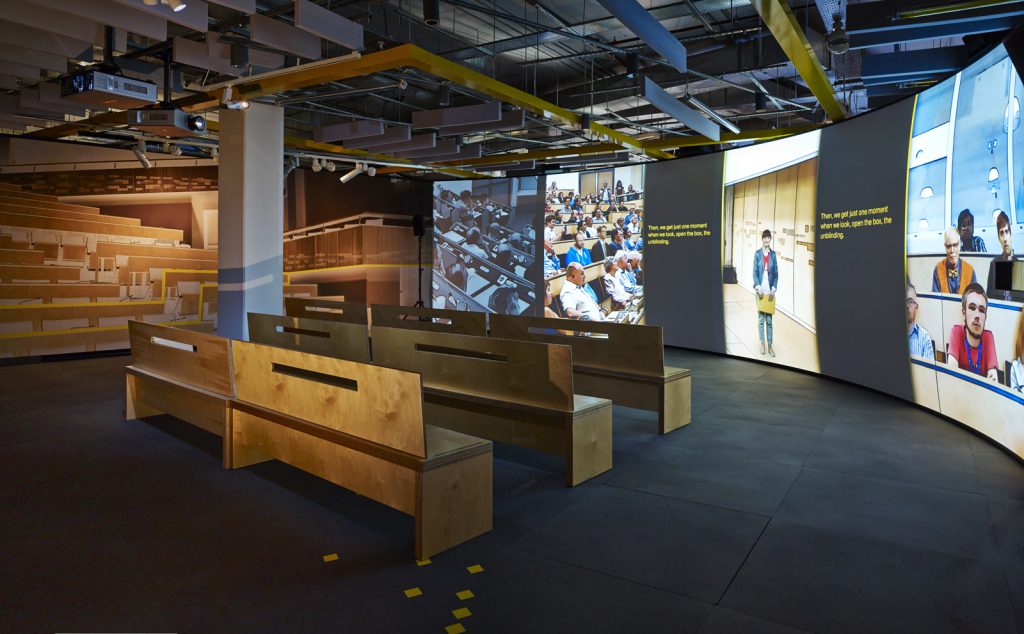
The objects displayed in Collider were chosen to represent the main stages in the lifecycle of a particle beam in the LHC, beginning with the source – a hydrogen gas canister – and including key elements of the Collider and the detectors. The choice of spaces to be recreated was in turn dictated by the objects, which were displayed in simulations of the environments where they would be found at CERN. Objects related to the LHC itself, such as superconducting magnets and accelerating cavities naturally found a home in the LHC tunnel, while parts of the four detectors were displayed as if on technicians’ workbenches. The environments were recreated using flat panels with high resolution photographs of the real locations at CERN, including several metres of concrete tunnel wall, complete with safety signs, scuff marks and graffiti. Additional 3D set dressing was then added, including workbenches, tools, shipping crates and computer monitors. The objects were enclosed in showcases or placed on plinths integrated into the stage sets, highlighted in yellow to help avoid confusion between real objects and set dressing.
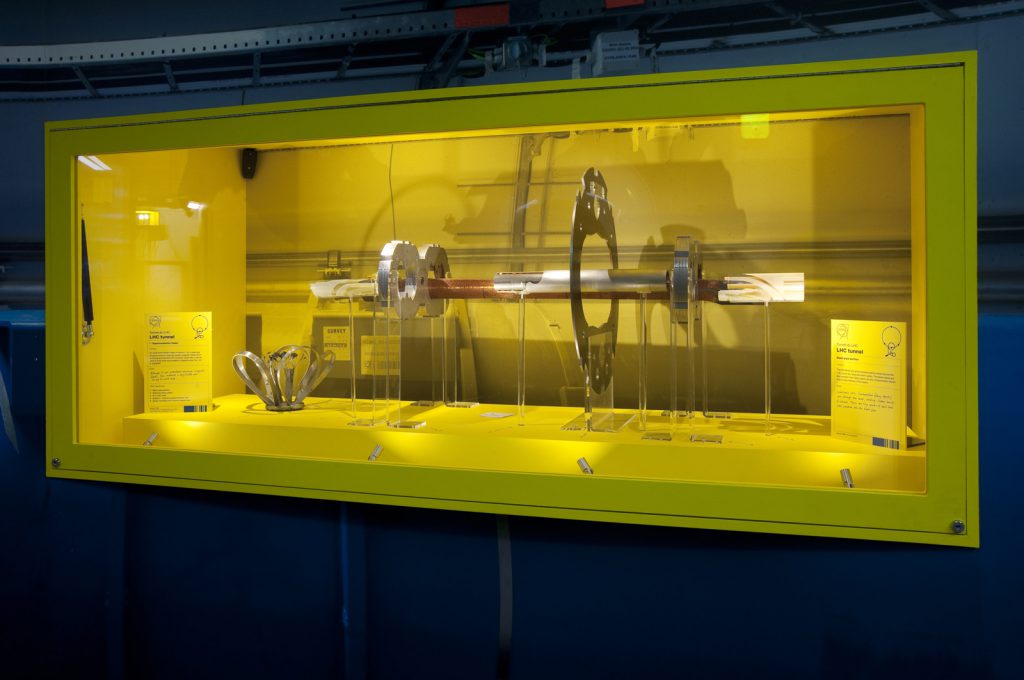
The conceit of the exhibition as a ‘visit to CERN’ presented a challenge in how to deliver content without the curatorial tone intruding and potentially breaking the sense of immersion. The voice of the Science Museum, usually encountered through object labels and text panels, was removed and instead the content was delivered in a ‘CERN natural’ form. Object labels remained, disguised as CERN-style forms used to track pieces of equipment as they moved around the laboratory, but text panels were done away with altogether. Abstract scientific concepts were discussed using hand-drawn sketches on whiteboards, as if drawn by a supervisor explaining a concept to one of his students. CERN’s own history was explored using a series of pin-boards, with images and Post-it notes recording significant events in the lab’s past.
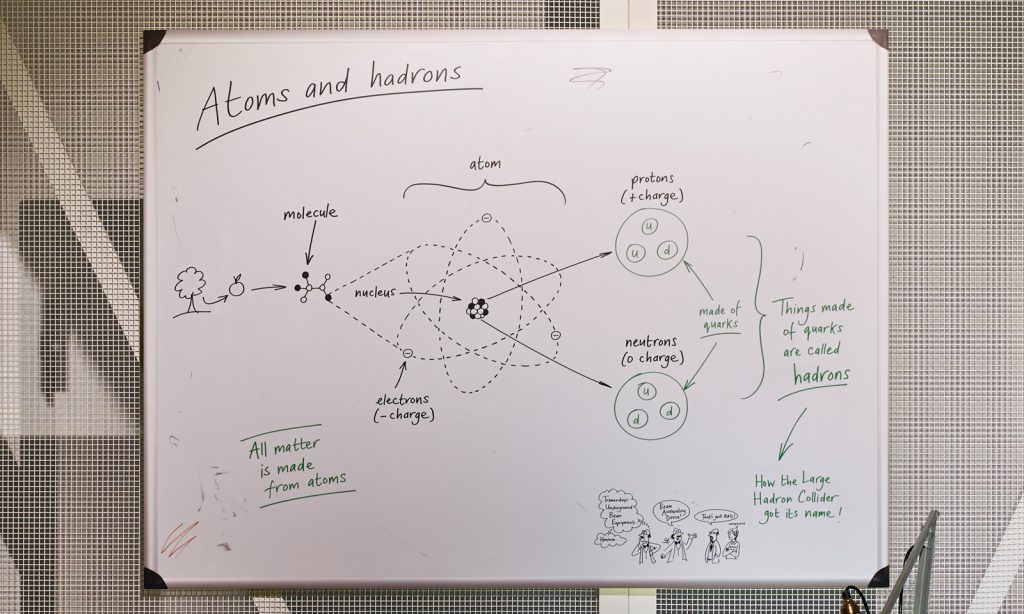
The objects were accompanied by video and audio recordings of engineers and physicists. In the ‘tunnel’, two engineers appeared as full size projections alongside the objects, while in the ‘detector lab’ each object was accompanied by an audio recording playing through a suitably shabby speaker. A small radio in the tunnel also played an edited documentary recounting the events of September 2008, when the LHC suffered a major ‘incident’ in which 750m of the Collider was damaged, setting operations back by a year. As well as delivering content, we hoped that using the words of CERN’s own personnel would give a human face to the complex physics and engineering, and enliven the exhibition spaces; as well as talking about their role on the LHC, the interviewees discussed the challenges and advantages of working in a large multinational organisation.
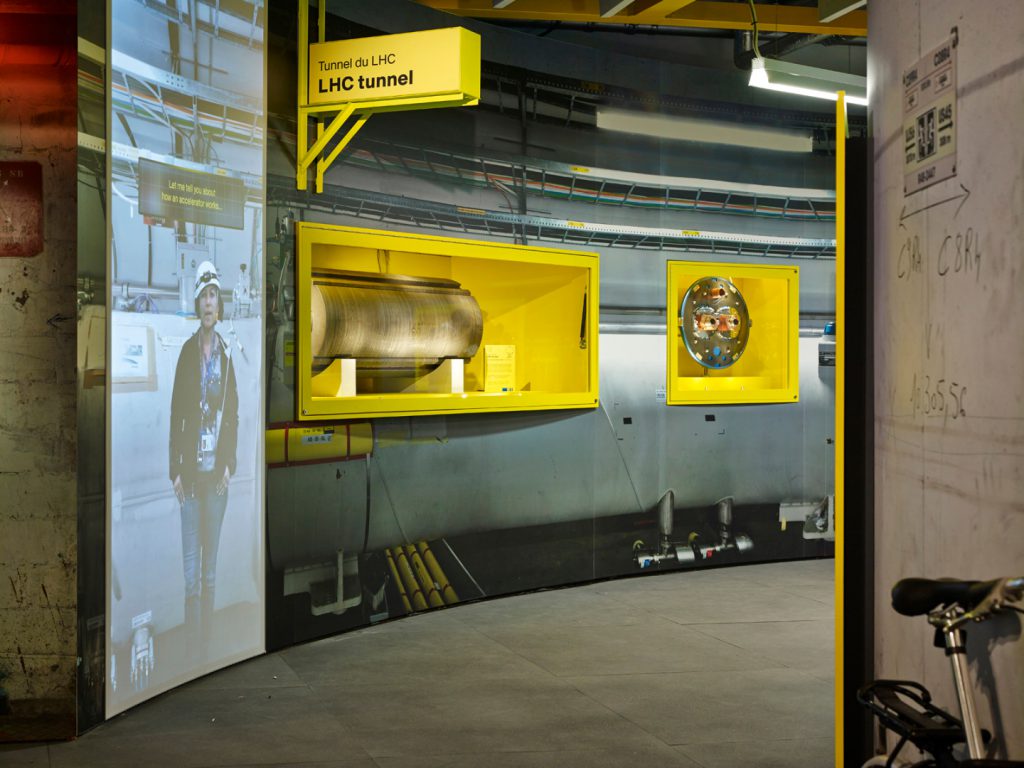
For aspects of the content without objects to lead us, there was more discussion about which of CERN’s spaces should be reproduced. An early concept for the scripted opening film was that it would be set in the CERN Control Centre, where visitors would ‘meet’ a number of fictional engineers who operate the LHC. During the development of the exhibition, it became clear that although this would be an effective vehicle for explaining what the LHC is and how it works, it would not allow for a discussion of the purpose of the LHC or recent discoveries that had been reported in the media (the Higgs boson discovery occurred while the exhibition script was being developed), as Control Centre engineers are not engaged in active particle physics research.
Instead, the first part of the film was set in CERN’s main auditorium, on the day when the discovery of the Higgs boson was revealed to members of one of the main experiments. On entering the exhibition, visitors were invited to take their seats in the auditorium, gaining privileged access to an event that in reality was closed to the public. The film told the story of the discovery using a number of characters whose words were based heavily on first-hand accounts, introducing both the purpose of the LHC and demonstrating the collaborative and international nature of the work. The Control Centre sequence, exploring what the LHC is and how it works, followed.
The greatest design challenge would be to deliver the sense of scale and awe that a real visitor to CERN experiences when visiting the four large particle detectors. In a fairly low gallery, and with the exhibition structure height limited to just over three metres so that it could be shipped internationally for the tour, this clearly could not be achieved using stage sets. Instead, Finn Ross Studio developed a 270 degree projected animation. Visitors stood in the centre of a large circular space, immersed in a piece of video art that zoomed down in perspective, from standing in front of a 15 metre tall particle detector, to inside a collision between two individual subatomic particles. Accompanied by a specially arranged orchestral track, the collision provided the audio-visual climax of the exhibition. While the animation gave an overview of how the LHC works and what it does, we avoided a spoken explanatory narrative: the aim here was to replicate something of the sense of awe on entering a detector cavern, and to explore particle physics as something beautiful in its own right.
The most difficult topic the exhibition had to tackle was how discoveries in particle physics are made using statistical analysis of large quantities of data. The abstracted and dislocated nature of this work made choosing an appropriate space challenging. In the end a faithful recreation of a CERN office corridor along with the office of a research physicist involved in the Higgs boson discovery was chosen. This was partly to provide a more reassuring visitor experience than the unfamiliar underground spaces – the content in this section, about the Higgs boson, being the most complex in the exhibition – while allowing us to provide a rich and light-hearted portrait of daily life at CERN, including conference posters, in-jokes, bus schedules, adverts for the table tennis club and personal effects like an abandoned pair of shoes and a cardigan. As Ludmilla Jordanova argues, ‘It is the responsibility of science museums to explain how science comes about’ (Jordanova, 2014); showing the reality of day-to-day work can help to temper heroic representations of science and scientists.
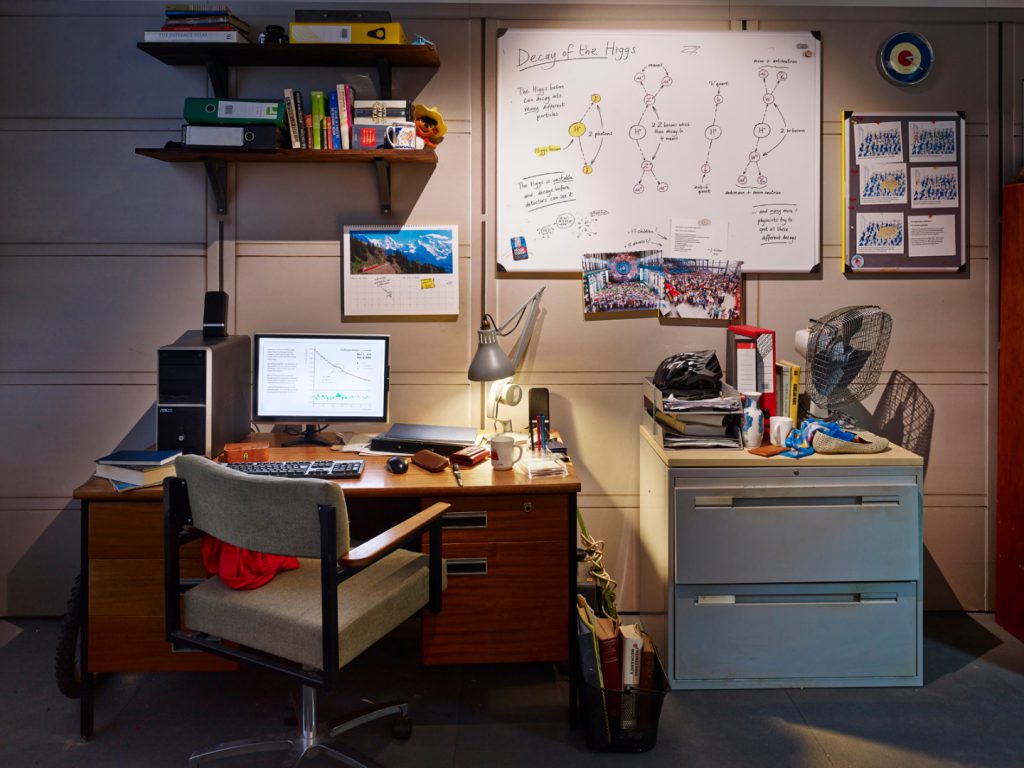
As a conclusion, the exhibition looked to the future of the LHC and what questions might be addressed in the coming years. The curators were keen on a recreation of Restaurant 1, where physicists would discuss their future research over a coffee, illustrating CERN’s internationalism and democratic nature. However, the designers advised that given the limited space available in the gallery it would not be possible to illustrate the size of Restaurant 1, and a reconstruction of a small area might feel too mundane. Instead, we opted for a more abstracted space, taking visitors out of the world of CERN to a digital environment showing the network of physicists involved in LHC research around the world.
Reactions to the exhibition
https://dx.doi.org/10.15180/140207/008Collider opened to the public on 13 November 2013, with media interest greatly boosted by the award of the Nobel Prize for Physics to Peter Higgs a month earlier. The approach of recreating CERN’s spaces was widely praised by critics, with The Independent’s Steve Connor writing that the ‘pocket-sized’ CERN was ‘in many ways…better than the real thing’ (‘A smashing show’, Connor, 2013), and TheEconomist noting that in addition to providing scientific explanations ‘the Museum pulled off the even harder trick of depicting CERN’s character’.
Particle physicists and CERN personnel who attended the exhibition broadly responded positively, with Director-General Rolf Heuer saying that he ‘recognised CERN’ in the exhibition, his only light-hearted criticism being that the size of the office space was far too large for a single PhD student. During the exhibition’s run in London a number of LHC personnel visited the exhibition with their children so that they could see what their parents’ workplaces were like – under-12s are not allowed underground at CERN.
The main test, of course, was how non-specialist museum visitors would respond, and as is usual within the Science Museum, summative evaluation was carried out.[6] In total 53,778 people visited Collider, of which 90 per cent were adults. One of the key aims of the project was to grow the Science Museum’s independent adult audience, and this seems to have been met to some extent; 22 per cent of visitors were completely new to the Science Museum, and a further 49 per cent had not been to the Museum for more than a year.
It is interesting to note that 40 per cent of visitors described themselves as having a keen interest in science, compared to 11 per cent among general Museum visitors. This is perhaps unsurprising given the subject of the exhibition, but also clearly indicates that the Museum had successfully engaged with this substantial and arguably under-served audience by offering them some ‘hard’ science.
We were pleased to find that 94 per cent of exhibition visitors were either ‘very satisfied’ or ‘fairly satisfied’ with the exhibition. Visitors responded well to the design and found the immersive environment ‘highly engaging’. They felt that the interpretation communicated the human side of life at CERN, the international nature of the project and the complexity of the engineering effectively and were particularly engaged by the full-height projections of real engineers and physicists. The most popular spaces in the exhibition were the ‘high-tech’ 270-degree collision projection and the mundane but more familiar office space of the particle physics researcher (Robinson, 2014).
However, with the recreated spaces visitors also experienced some of the issues found in previous museum examples. Despite the use of a graphic language to highlight real objects, visitors were sometimes unclear what was real or fake within the environment. The unfamiliarity of particle physics objects and the fact that most were labelled as prototypes (without making the role of a prototype in the LHC’s engineering and design process clear) is likely to have been a contributing factor and more explicit label text should reduce this problem.
Linked to this, some visitors were unsure as to whether the objects were ‘actual size’, or scale models. There was an apparent dissonance between the descriptions and representations of ‘cathedral-sized’ spaces and machines in the immersive films and exhibition marketing and the more everyday scale of the artefacts on show. Although diagrams were used to place small artefacts in the context of the much larger devices of which they were components, many visitors seemed to miss them or fail to understand their meaning. There is an important lesson to learn here: though diagrams and blueprints are useful to those with experience of reading them, to many visitors they are quite opaque and alternative methods should be found to convey scale and context.
However, the 270-degree projection space did seem to overcome the physical limitations of the gallery, giving visitors a much better feel for the scale of the LHC. It was also pleasing to find that although this space carried no narration or factual information the visuals alone were sufficient to give most visitors a clear understanding of how the particles collide and how these collisions are detected and studied.
A particularly interesting finding of the research was that visitors felt somewhat let down by what they perceived as CERN’s shabbiness. Mass media portrayals of the LHC’s visually spectacular detectors, and CERN’s reputation as an innovative and cutting-edge laboratory, led visitors to expect something much more glamorous. For the Museum, showing the reality of life at CERN was part of the exhibition learning strategy, but this provides a useful caution about balancing curatorial desire for realistic reconstructions with visitors’ preconceived expectations, however misguided these may be. The exhibition marketing has a role to play here.
The desire to create a realistic simulation of a visit to CERN, coupled with the abandonment of overt museum-style content, required visitors to work harder to understand the content. Some visitors lamented the lack of interactive exhibits, which we had avoided as one would not find these at CERN. In fact, it is extremely difficult to conceive of an interactive installation that could explain the physical phenomena under investigation with any degree of scientific accuracy, so for this particular topic guided tours and talks by particle physicists are likely to be a better way to provide in-depth content.
The ‘visit’ style also led some visitors to wonder if the exhibition was a mouthpiece for CERN – particularly as they were aware of the laboratory’s high media profile (Rostvik, 2014). In fact, CERN had no editorial control over the exhibition content, although the curatorial team inevitably had a close working relationship with CERN personnel. The portrayal of CERN in the exhibition ultimately reflected the experience of a visit to the site, and we believed that visitors to the recreation were just as capable of forming their own opinion of CERN as visitors to the real place.
Ultimately, Collider did not set out to provide a critical perspective on CERN (although the historical display prior to the ticketed exhibition explored broader themes about particle physics), or to teach visitors complex fundamental physics. The aim was to enthuse visitors about cutting-edge science, overcoming their fears of an abstract and complex subject. We have found inviting visitors into the spaces of CERN, in all their messy reality, to be highly effective in this regard, with over 90 per cent of visitors understanding the core messages of the exhibition (Robinson, 2014). Although developed independently, the exhibition’s approach is somewhat similar to the documentary film Particle Fever directed by Mark Levinson, which followed the lives of a number of particle physicists in the years leading up to the discovery of the Higgs boson and its subsequent impact. (This was not available to view before exhibition opening, but was screened during the London run). Alan Friedman, consultant in museum development and science communication, noted that ‘the film can communicate something vitally important about science – as long as we accept that a part of science and of science education lies in the affective domain. This film can show what most textbooks and most museum exhibitions do not communicate successfully: the interests, attitudes, and emotions people feel when they learn and do STEM’ (Friedman, 2013, original emphasis).
Recreated spaces, with their capacity for affective learning, can be an important part of the exhibition toolkit, and we suspect Collider will not be a lone example in the sciences as curators once again embrace reconstructions. Combined with insights from historians re-engaging with laboratory studies, the approach offers an intriguing prospect for future interpretation in science and technology museums.
Acknowledgements
The authors would like to thank all those involved in creating Collider.
Tags
Footnotes
Back to text
Back to text
Back to text
Back to text
Back to text

